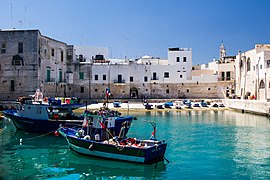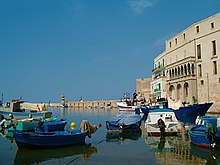Monopoli
| Monopoli | ||
|---|---|---|

|
|
|
| Country | Italy | |
| region | Apulia | |
| Metropolitan city | Bari (BA) | |
| Coordinates | 40 ° 57 ′ N , 17 ° 18 ′ E | |
| height | 0 m slm | |
| surface | 156 km² | |
| Residents | 48,819 (Dec 31, 2019) | |
| Population density | 313 inhabitants / km² | |
| Post Code | 70043 | |
| prefix | 080 | |
| ISTAT number | 072030 | |
| Popular name | Monopolitani | |
| Patron saint | Madonna della Madia | |
| Website | Monopoli | |
 Monopoli, the old port |
||
Monopoli is a city with 48,819 inhabitants (as of December 31, 2019) in the Italian region of Apulia , metropolitan city of Bari on the Adriatic Sea , about 40 kilometers from the provincial capital Bari .
history
Monopolis was already on the ground from the middle of the 2nd millennium BC. An apparently relatively large Bronze Age settlement, as found in the Via Papacenere and at the Piazza Palmieri show. It existed from the Proto- Appenninic B (approx. 15th century BC) to the end of the Bronze Age (11th century BC). In addition to the remains of buildings, hearths and local pottery, some fragments of vessels of Aegean origin, including two pieces of Mycenaean pottery , which indicate trade with Greece, were discovered. The name of this settlement is unknown.
The monopoly of classical antiquity , a small village founded by Greece , was subordinate to the city of Gnathia (Egnatia). After the destruction of Gnathia by the Ostrogoth king Totila in 545, its inhabitants fled to Monopoli, which from then on lived up to its meaning as the “only city” (literal translation of the city's name). In the following centuries the area was ruled by Normans , Byzantines and Staufers , Spaniards , Habsburgs and Bourbons.
When the city came under Venetian control in 1484 , a period of economic boom began. This was due to the development of the port, the only safe base between Bari and Brindisi , as well as the trade in agricultural products (oil, almonds, carob, wine) from the hinterland. In 1530 the Venetian rulers wanted to raise Monopoli to a barony . However, this request was thwarted by the local population, who bought themselves out with 51,000 gold ducats .
Under Spanish rule Monopoli became a free city again in 1545, whereupon the city walls were expanded and the old castle of Henry VI. and Friedrich II. were restored. 1713 to 1734 the place was Habsburg and then came under the rule of the Bourbons . In 1860 Monopoli, like the Kingdom of the Two Sicilies, was annexed to the Kingdom of Italy .
About a kilometer northwest of the city center is the Grotta della Mura . Excavations in 2006 revealed an abundance of archaeological layers . The oldest finds come from the Middle Paleolithic . A child burial from the Upper Paleolithic and jewelry pendants made from bones from the same period are remarkable .
Attractions
Castello of Emperor Charles V (1552)
Twin cities
Monopoli has been a city partner of Lugoj in Romania since 2007 . There has been a town partnership with Lyss in Switzerland since 1982 .
Web links
Individual evidence
- ↑ Statistiche demografiche ISTAT. Monthly population statistics of the Istituto Nazionale di Statistica , as of December 31 of 2019.
- ^ Marco Bettelli: Italia meridionale e mondo miceneo. Ricerche su dinamiche di acculturazione e aspetti archeologici, con particolare riferimento ai versanti adriatico e ionico della penisola italiana. Florence 2002, p. 23f (with further literature).
- ↑ Summary of the 2006 excavations Grotta delle Mura at FastiOnline (English)
- ↑ Monopoli gemellata. In: comune.monopoli.ba.it. Retrieved September 19, 2019 (Italian).








